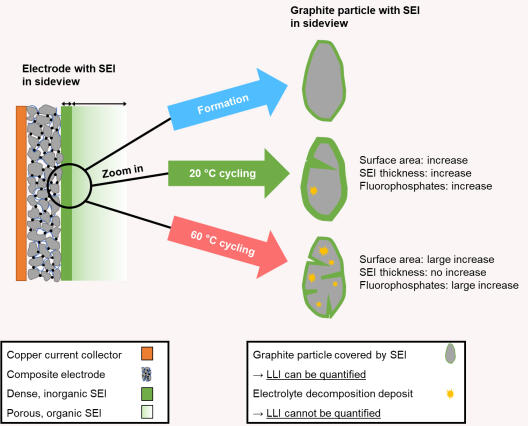Extent of Interphase Growth on Capacity Loss in Aged Battery Cells Quantified
A decisive factor for the performance of lithium-ion batteries are the solid electrolyte interphase (SEI) and the cathode electrolyte interphase (CEI). A team from MEET Battery Research Center at the University of Münster has studied these interphases, that form at the interfaces of the electrodes with the electrolyte, using X-ray photoelectron spectroscopy (XPS) combined with nitrogen adsorption. The scientists demonstrated that the increase in layer thicknesses can explain the lithium and thus capacity losses in the cells only to a minor extent. Instead, they identified that heterogeneous residues on the negative electrode, which are not part of the SEI, bind a significant portion of the lost lithium. With these clever combination of methods, the researchers were also able to show that the surface area of both the negative and positive electrodes increases greatly with aging.

Combination of Methods Yields New Insights
MEET scientist Bastian Heidrich explains, "For the first time we combined the method of nitrogen adsorption to determine the surface area with the layer thicknesses measured by XPS to capture the possible SEI and CEI growth in three dimensions. We were able to show that the thickness growth of the SEI is indeed very small, while the CEI grows significantly thicker. Both the positive and the negative electrode had an increased surface area after aging." With this, the researchers identified the increase in interphase thickness but more importantly the increase in specific surface area as impacting factors for capacity loss. Especially at elevated cycling temperature, a notable portion of the lost lithium was immobilized within heterogeneous residues on the negative electrode, which are not part of the SEI. The continuous areal growth of the SEI and heterogeneous aging processes are thus the decisive factors for the capacity loss.
Complete Study Online Available
The detailed results of their study have been published by the authors Bastian Heidrich, Maik Stamm, Dr Olga Fromm, Johanna Kauling, Dr Markus Börner and Dr Philip Niehoff, MEET Battery Research Center, and Prof. Dr Martin Winter, MEET Battery Research Center and Helmholtz Institute Münster, in the "Journal of The Electrochemical Society".

